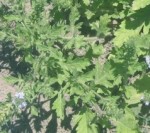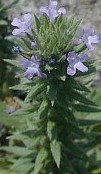 Prostrate vervain is a native weed that grows as an annual or short-lived perennial throughout the United States. It likes a sunny site with dry, infertile soil and often grows in pavement cracks. It thrives along roads and driveways where the sandy, gravelly soil is common but may invade shrub borders, perennial beds, and lawns where the soil is not regularly cultivated. When extreme drought occurs the lower leaves and stems may turn brown but the plant persists.
Prostrate vervain is a native weed that grows as an annual or short-lived perennial throughout the United States. It likes a sunny site with dry, infertile soil and often grows in pavement cracks. It thrives along roads and driveways where the sandy, gravelly soil is common but may invade shrub borders, perennial beds, and lawns where the soil is not regularly cultivated. When extreme drought occurs the lower leaves and stems may turn brown but the plant persists.

 Description: Prostrate vervain is a low growing sprawling plant that may form dense mats. The multiple stems are branched, 6 to 12” long, angular, and covered with long white hairs. The lower leaves are opposite, 3” x 1” in size, and are divided into three lobes that are further divided into secondary lobes. Upper leaves are smaller and divided only once. Spikes of hairy lanceolate bracts and small white, blue or purple 5-petaled flowers are produced from May into fall. A single colony can be in bloom for 2-3 months. Each flower is replaced by a hairy capsule containing four nutlets. Plants spread by reseeding. A taproot anchors the plant.
Description: Prostrate vervain is a low growing sprawling plant that may form dense mats. The multiple stems are branched, 6 to 12” long, angular, and covered with long white hairs. The lower leaves are opposite, 3” x 1” in size, and are divided into three lobes that are further divided into secondary lobes. Upper leaves are smaller and divided only once. Spikes of hairy lanceolate bracts and small white, blue or purple 5-petaled flowers are produced from May into fall. A single colony can be in bloom for 2-3 months. Each flower is replaced by a hairy capsule containing four nutlets. Plants spread by reseeding. A taproot anchors the plant.

 Control: Removing the plant by hand pulling or hoeing before flowers set seeds is effective and plants will not grow back if part of the taproot is left in the ground. Selective broadleaf herbicides containing 2,4-D and dicamba are helpful for lawn problems.
Control: Removing the plant by hand pulling or hoeing before flowers set seeds is effective and plants will not grow back if part of the taproot is left in the ground. Selective broadleaf herbicides containing 2,4-D and dicamba are helpful for lawn problems.